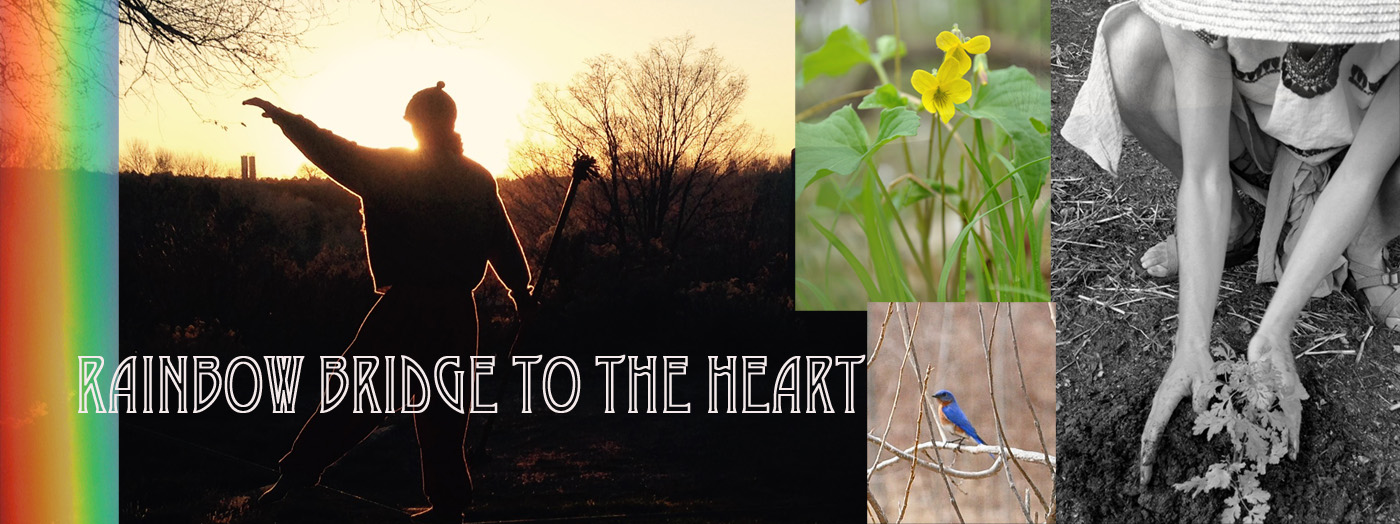Spring is an exciting time for those who like to eat wild leaves. The transition to abundant growth from the state of dormancy is an amazing and uplifting time. A great time to make the first trips to hunt for herbs, especially those that have stored up energy from the previous year, be it perennials (numerous year life cycle) or biennials (2 year life cycle).
Garlic mustard (Alliaria petiolata), also known as poor man’s mustard, garlic root, garlic wort, hedge garlic, and jack-by-the-hedge is one of the most rampant and widespread wild edibles in Eastern North America, and come April (depending on where you live) yields copious leaves and young flowers. Its native range spans much of Europe, western and central Asia, and northwestern Africa as well as Scandinavia. In its natural habitat, it has been used for up to 6100 years ago in culinary applications. It is considered an invasive species here in North America as it establishes itself aggressively in forest under stories, able to out-compete native plants. The main reason for this is the allelopathic chemicals or allelochemicals that inhibit mycorrhizal fungi (the fungi in the root zone that live in symbiosis with native plants). These chemicals do not seem to have the same effect in its natural range.
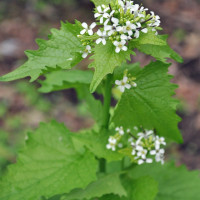
So, to make best use of an abundant resource, eat it! The roots are edible (usually harvested before flower stalks emerge) but mainly its the leave and tender stem that we’re after. Garlic mustard is a biennial, sending up its flowering stalk in the second year of growth. This flowering stalk is the focus for collection in April to late May. One strategy for control of this invasive is persistent removal of plants (continued for 5 years), so you may be actually doing your local ecosystem and your body favor by eating this plant.
“Garlic mustard greens are very nutritious as they have substantial amounts of vitamins A, C, E and some of the B vitamins. In addition this wild weed contains potassium, calcium, magnesium, selenium, copper, iron and manganese as well as omega-3 fatty acids.” (source)
The edges of forested areas are the best place to look for this immunity supporting antioxidant rich herb. Full sun allows for more luscious leaf growth. Find a patch a distance away from areas that spray chemical on lawns, along roadsides or anywhere pollution might be an issue. Leaves are particularly susceptible to accumulating harmful chemicals.
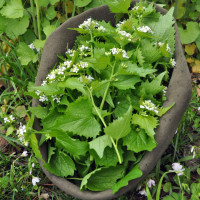
Pick the upper 4 leaves or so including the stem and flowers, as all parts are edible in sauces and pestos, raw in salad or prepared as steamed greens (don’t cook more than 5 minutes unless you like mush). They wilt quickly, so try to use them as soon after harvest as possible. Bring along a useful item like a bag, basket or hat to store the goodies. This picture features the ever-useful Andean felt hat on sale here.
Here’s a recipe I made after an abundant harvest. Be warned its not your average pesto, it is piquant and reminiscent of horse radish in taste and mouth sensation. This version is quite pungent and salty, and is suggested to use sparingly. If less salt is desired, decrease by half.
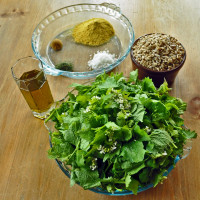
Ingredients
4 Cups coarsely chopped garlic mustard tops
1 1/2 Cups sprouted sunflower seeds
1/2 Cup olive oil
1/4 Cup nutritional yeast
2 tsp coarse sea salt
1 tsp cumin
1 tsp dry dill
Place the oil, salt and spices and half the seeds and garlic mustard in food processor. Blend together, adding the remaining seeds and garlic mustard bit by bit as not to overwhelm your machine. When blended fully, add the nutritional yeast as the final ingredient. Now eat it!
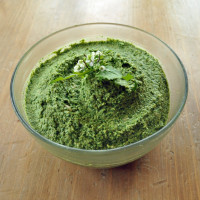
Sources:
Flora Europaea”. Royal Botanic Garden Edinburgh.
Saul, Hayley; Madella M, Fischer A, Glykou A, Hartz S, et al (August 21, 2013). “Phytoliths in Pottery Reveal the Use of Spice in European Prehistoric Cuisine”. PLOS ONE (PLOS).doi:10.1371/journal.pone.0070583. ISSN 1932-6203. Retrieved August 22, 2013.
Stinson KA, Campbell SA, Powell JR, Wolfe BE, Callaway RM, et al. (2006). “Invasive Plant Suppresses the Growth of Native Tree Seedlings by Disrupting Belowground Mutualisms”. PLoS Biology 4 (5): e140.doi:10.1371/journal.pbio.0040140. PMC 1440938. PMID 16623597.
